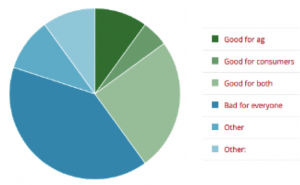Forty Senators are calling on the Environmental Protection Agency (EPA) to strengthen biodiesel volumes in the proposed 2018 rules for the Renewable Fuel Standard (RFS). The senators said that biodiesel and renewable diesel are providing the vast majority of renewable fuel under the Advanced Biofuels category and the EPA should do more to encourage growth.
 “The biodiesel industry has met RFS criteria for growth, exceeding the goals that Congress envisioned when it created the RFS with bipartisan support in 2005 and supporting over 47,000 jobs,” the letter states. “To date, biodiesel and renewable diesel have delivered the majority of the advanced biofuels under the RFS. We believe it is clear that these fuels offer the best opportunity for growth in the near future.”
“The biodiesel industry has met RFS criteria for growth, exceeding the goals that Congress envisioned when it created the RFS with bipartisan support in 2005 and supporting over 47,000 jobs,” the letter states. “To date, biodiesel and renewable diesel have delivered the majority of the advanced biofuels under the RFS. We believe it is clear that these fuels offer the best opportunity for growth in the near future.”
The letter was led by Sens. Roy Blunt ( R-Mo.), Patty Murray (D-Wash.), Chuck Grassley, (R-Iowa) and Heidi Heitkamp (D-N.D). It was signed by a bipartisan group of additional senators from California to Minnesota to Maine.
“I think this letter reflects a growing consensus on Capitol Hill that biodiesel and renewable diesel are successfully delivering the economic and environmental benefits that Congress had in mind when it created the RFS,” said Anne Steckel, vice president of federal affairs at the National Biodiesel Board (NBB). “This is a success story, and hopefully this letter helps show the Obama administration and the EPA that we need to do more. We need to embrace growth in our cleanest fuels, and the EPA proposal as it stands falls short of that.”
“On behalf of biodiesel producers around the country we want to thank all the senators who signed this letter, particularly Sens. Blunt, Murray, Grassley and Heitkamp for their leadership in organizing the effort,” Steckel added.
The additional senators signing the letter were Tammy Baldwin (D-Wis.), Richard Blumenthal (D-Conn.), Barbara Boxer (D-Calif.), Sherrod Brown (D-Ohio), Maria Cantwell (D-Wash.), Bob Casey (D-Pa.), Susan Collins (R-Maine), Joe Donnelly (D-Ind.), Richard Durbin (D-Ill.), Joni Ernst (R-Iowa), Dianne Feinstein (D-Calif.), Al Franken (D-Minn.), Martin Heinrich (D-N.M.), Mazie Hirono (D-Hawaii), John Hoeven (R-N.D.), Angus King (D-Maine), Mark Kirk (R-Ill.), Amy Klobuchar (D-Minn.), Patrick Leahy (D-Vt.), Ed Markey (D-Mass.), Claire McCaskill (D-Mo.), Jeff Merkley (D-Ore.), Jerry Moran (R-Kan.), Gary Peters (D-Mich.), Jack Reed (D-R.I), Pat Roberts (R-Kan.), Mike Rounds (R-S.D.), Bernie Sanders (I-Vt.), Jeanne Shaheen (D-N.H), Debbie Stabenow (D-Mich.), Jon Tester (D-Mont.), John Thune (R-S.D.), Tom Udall (D-N.M.), Elizabeth Warren (D-Mass.), Sheldon Whitehouse (D-R.I.), and Ron Wyden (D-Ore.).
![]() There will be a free ethanol safety seminar on Saturday, July 30, in Adams, Nebraska hosted by the Renewable Fuels Association (RFA) in conjunction with the International Association of Fire Chiefs, the Pipeline and Hazardous Materials Safety Administration, Ethanol Emergency Response Coalition and TRANSCAER.
There will be a free ethanol safety seminar on Saturday, July 30, in Adams, Nebraska hosted by the Renewable Fuels Association (RFA) in conjunction with the International Association of Fire Chiefs, the Pipeline and Hazardous Materials Safety Administration, Ethanol Emergency Response Coalition and TRANSCAER.









